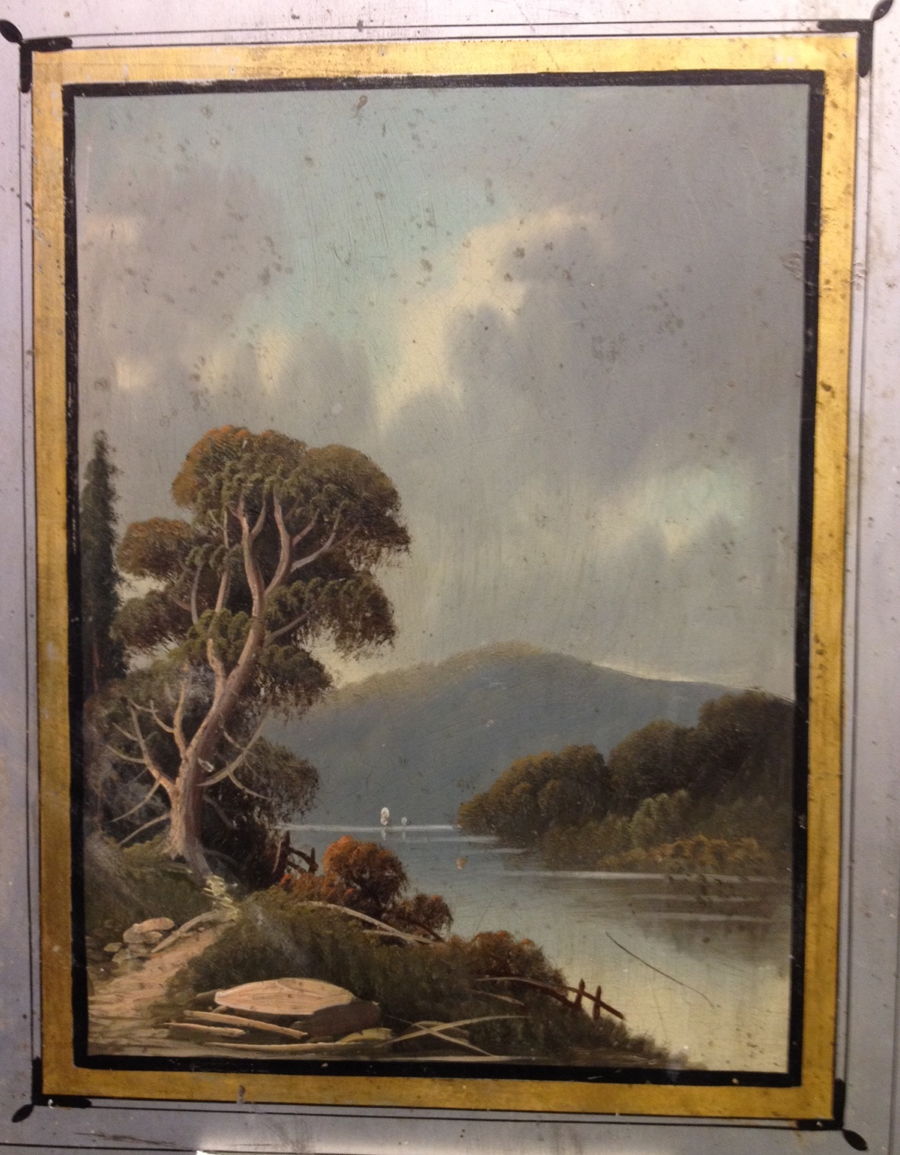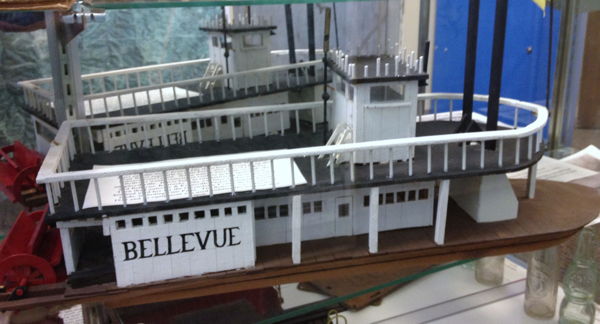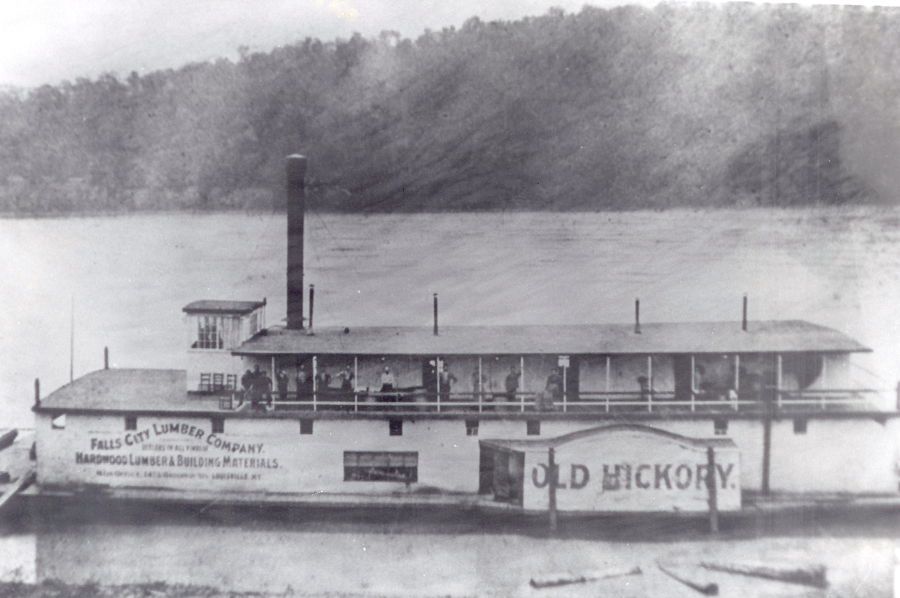
The following article by David Strange originally appeared in The Courier-Journal on 13 Mar 2013. It is archived here with additional information for your reading enjoyment.
If you visit the Bullitt County Courthouse, and go into the south display room of the county history museum located there, you will see an old, silver-painted safe the size of a door.

On that safe door, you will see a small painting of the Salt River.
That is not by chance.
The rivers of Bullitt County are the historic heart of the county. The flow of their waters once acted as the life-giving arteries of agriculture and early transportation.
In pioneer days, and long before, when the only other way of transportation through the deep forests was to follow the narrow, meandering animal paths of the Wilderness Road, a navigable river could feel like a highway.
Even when settlements came, and land was cleared, a relatively clean and smooth ride of a boat down the river could be like Heaven, compared to a long wagon-ride on a bumpy, dusty road.
This was even more so with the coming of steamboats in the early 1800's.
West Point, on the Ohio River at the mouth of the Salt River, was a regular stop for river traffic. Some steamboats would enter the Salt River from there, following that river a few miles up to the town of Pitts Point at the junction of Salt River and the Rolling Fork.
But from there, the river could be difficult for a large boat to travel.
Sometimes, during high water, the steamboats would venture up the Salt River as far as Shepherdsville, but not often. They could, however, usually make it to a point about three miles downstream from that town. I have heard over the years that large iron rings or chains could be found at the spot where they would tie off.
In those days, there was sort of a love/hate relationship with the rivers. Regular flooding could cause much trouble and damage, but the high water allowed bigger boats, and more commerce, to travel the little rivers that would normally be too shallow for much more than small flatboats.
During a flood in April, 1912, one small sternwheeler, the Nettie Grant, (named as the Nellie Grant in some records) ventured as far up the Salt River as any I know. It traveled up the river a number of miles above Shepherdsville, until the way was blocked, one writer says, by an iron bridge. Captained by Jesse Singleton, the crew had to take the stack down to get under the bridge at Shepherdsville that had just been built a few years before. It was quite a sight to those upstream who had not seen a steamboat before. It stayed a few days, providing excursions between Greenwell's Landing, Burch Brothers' Landing, and Shepherdsville. It then loaded lumber and railroad ties, and headed back downstream with the lowering waters.
An 1837 survey of the Salt River, Floyds Fork, and Rolling Fork area supported the idea to build a series of locks and dams on the Salt and Rolling fork, to make them more navigable. It was urged that dams and locks be built on the Salt at about the eleven, twenty, twenty-one, and twenty-three mile markers from the mouth of the river, and that two locks and dams be built on the Rolling Fork. But the development of railroads such as the L&N in the 1850's began to cause some river traffic to be less viable, especially in smaller rivers such as the Salt. And though the idea was still being considered as late as 1903, construction of locks was never done.
River ice in winter, and low water in summer, were not problems for railroads, making them increasingly more reliable than steamboats.
Interestingly, that same 1837 survey tells about the falls area of Salt River, just downstream from Shepherdsville, providing power for an iron forge operation, and that a rolling mill was under construction. Remnants of the dam that powered the water wheel can still be found by those who know where to look.

Another steamboat that traveled part of the Salt River was the Bellevue sternwheeler. The Bellevue was built in 1890 in Levenna, Ohio. She traveled the Ohio and Salt Rivers along with her sister boats, the Mattie Hays and the Nettie Grant. The three boats would go up the Salt River regularly to Pitts Point, now part of Fort Knox Military Reservation. When waters were high enough, the Bellevue would sometimes venture as far upstream as Shepherdsville. It was later used to tow barges carrying stone. Then the Louisville & Evansville Packet Company bought her and used her for the Owensboro-Evansville to Louisville trade, including Pitts Point. The Bellevue was retired in 1912 and its equipment was used in the building of the towboat Red Spot.
The Mattie Hays was a small two-decked packet boat operated in the Salt River trade. Owned by the Louisville and Henderson Packet Company, it was 100 foot in length, only drawing 3.4 feet of water, which allowed her to go much further up the often-shallow Salt and Rolling Fork rivers than most other steam boats. It worked the Salt River for nearly 20 years. Cargo would usually be hay, timber & wood products, and livestock.

Old Hickory was a well-known side-wheel steamboat owned by Peter Martin and traveled on the Salt and Rolling Fork rivers. It served as a traveling saw-mill, cutting and hauling lumber and railroad ties. Old Hickory burned and sank at West Point before 1900.
Other boats included Market Boy, which sunk near Mosquito Creek near West Point, and the Clermond, Jingo, Raymond, and Reindeer,as well as the Adelaide which was promoted as the first steamboat to go up the Salt River as far as Shepherdsville.
Riverboat traffic eventually faded with the coming of railroads and automobiles.
When the Fort Knox military reservation expanded across the Salt River in the mid 1900's, river traffic was restricted. And when America suffered the 9-11 attack of the World Trade Center and the Pentagon, security measures virtually eliminated all civilian traffic through the Fort Knox portion of the river.
And so, the rivers of Bullitt County settled back down to tranquil scenes such as that depicted in the painting on the old courthouse safe door.
Memories now are more of canoeing adventures and of fishing stories.
But long ago, you could have heard the whistle of a steam boat off in the distance, when children and adults would run across the fields to see the wonder of a great machine traveling along on the river, the captain waving from his lofty perch.
Ah! What a sight that must have been!
Copyright 2013 by David Strange, Shepherdsville KY. All rights are reserved. No part of the content of this page may be included in any format in any place without the written permission of the copyright holder.
The Bullitt County History Museum, a service of the Bullitt County Genealogical Society, is located in the county courthouse at 300 South Buckman Street (Highway 61) in Shepherdsville, Kentucky. The museum, along with its research room, is open 10 a.m. to 4 p.m. Monday through Friday. Saturday appointments are available by calling 502-921-0161 during our regular weekday hours. Admission is free. The museum, as part of the Bullitt County Genealogical Society, is a 501(c)3 tax exempt organization and is classified as a 509(a)2 public charity. Contributions and bequests are deductible under section 2055, 2106, or 2522 of the Internal Revenue Code. Page last modified: 12 Sep 2024 . Page URL: bullittcountyhistory.org/memories/ontheriver.html